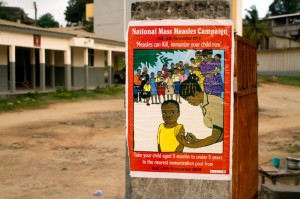Flooding in Ghana, Benin, Nigeria
Tomorrow is the beginning of the Social Mobilization phase of the measles campaign, trying to get the word out (especially to undervaccinated populations) about the measles exercise.
 We’re meeting with the disease control team from Mfantsiman District at 5am to shadow them as they head to various villages (including Akatekywa). Teams in the northern regions of Ghana may have a fight on their hands as we’ve had unseasonal rains for the last month and there is severe flooding in many parts of the north (this is following a controlled release of a dam in Burkina Faso — a release that generally spells misery for many northerners before the unseasonal rains are factored in).
We’re meeting with the disease control team from Mfantsiman District at 5am to shadow them as they head to various villages (including Akatekywa). Teams in the northern regions of Ghana may have a fight on their hands as we’ve had unseasonal rains for the last month and there is severe flooding in many parts of the north (this is following a controlled release of a dam in Burkina Faso — a release that generally spells misery for many northerners before the unseasonal rains are factored in).
There is also currently significant flooding in Benin (which is directly east of our nearest eastern neighbor, Togo), displacing 680,000 people so far. Here is a large map of the affected areas.
Mostly southern Benin is affected, and if you look at Cotonou on google maps it will be immediately evident why. Some of the flooding has taken place in the north, however, and has also affected Nigeria. The Nigerian state reporting the most measles outbreaks this year is also the most flooded, a correlation that is likely not coincidental. In general the north of Nigeria tends to be much worse off than the south (an earlier New York Times article I’ve linked when discussing the MDGs claims under 5 mortality as reported by UNICEF is 220 (per 1000) in the north but only 80 in the south).
And in a Nigeria and Ghana related note, I just read an article on using traditional breeding methods to develop a vitamin A rich variety of cassava. Cassava is a staple crop in West Africa — you can see it being sold on a huge portion of streetcorners in Accra (why every seller has 7 or 8 of them stacked in his arms I have yet to figure out; it would seem easier to balance a basket on his head like every other vendor of every other type of product in the country), and as the article points out it is “all carbohydrate.” Cassava is used to make gari, which is essentially a ‘filler’ in dishes here (it’s also used to make fufu, something I have written about previously and also described as ‘filler’). So a vitamin A dense cassava would be significant indeed, as vitamin A deficiency plays a huge role as a determinant of sickness in children (it’s associated with as much as a 50% rise in mortality when comorbid with measles, and the original study by Al Sommer that found the vitamin A link recorded a 30% reduction in mortality for children who were given vitamin A (two cents worth of vitamin A, as the link notes)).
This upcoming measles campaign in Ghana won’t see bednet distribution, but it will see measles jabs and vitamin A distribution. It would be nice to see a day when both measles and vitamin A campaigns aren’t needed anymore.
We are also keeping an eye on Nigeria (and beginning to plan for a visit) ahead of their January measles campaign (and learning more now about some high-risk-area interventions to take place in November), and there’s been some press coverage of Nigeria asking for more UN assistance with measles and polio eradication.
The UNF is also featured in a story claiming India’s lack of progress against measles (of all the children in the world who went unvaccinated in 2008, more than 1/3 were in India) is due to leadership changes in their health services. I think that only tells a part of the story, as the larger the country the larger the logistical difficulty in reaching all of the children in a given cohort. Nigeria deals with this same problem, as Africa’s most populous country (and had the second highest number of unvaccinated children of any country in 2008), and their population is only 1/7th that of India. The main determinant, however, is not leadership changes or even geography, but India’s decision in 2001 not to implement WHO immunization policies. Why these policies weren’t implemented is, I guess, what the article is trying to get at, but whatever the case there are 47 “priority countries” and 46 of them implemented the WHO policies, leaving India as the odd-country-out and many Indian children there to fend for themselves against measles.








